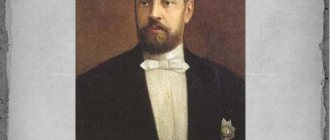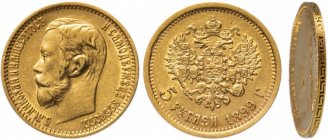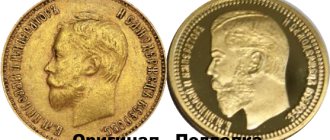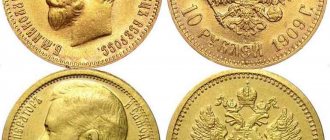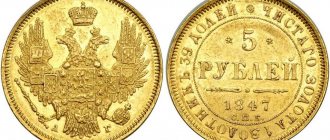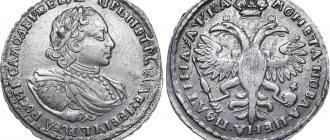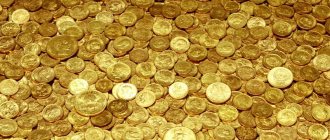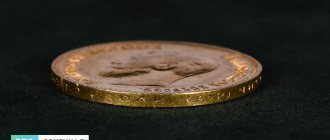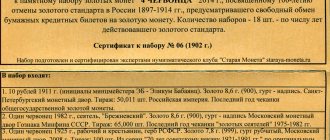History of appearance
The appearance of the gold coin in 1900 is associated with the reform of the Minister of Finance of the Russian Empire, S. Witte, as a result of which, from 1897, coins began to be minted from this metal. They were of different denominations. However, it was 10 rubles, issued in 1898-1911, that became the most popular and beloved among the people. They are now called royal chervonets.
However, at the time of circulation they had a completely different name.
Golden chervonets - Soviet gold coins with a face value of 10 rubles - were minted in the 20s of the last century. Later, this term began to be applied to the royal ten-ruble notes. By the way, in the 20s, the Soviet chervonets did not inspire confidence in international payments, and, according to one version, the new government stamped a batch of Nikolaev 10-ruble notes for settlements, because the stamps were at their disposal. This variety is also a collectible variety, but we are not talking about it today.
About monetary reform
At the very beginning of his ruling career, the emperor decided to carry out a monetary reform, the essence of which was that it was necessary to stabilize gold money - that is, to reduce the circulation of paper denominations and increase the number of coins by about 18 times.
This reform affected primarily 10 rubles. The weight of this coin has changed, which has changed significantly by as much as 4.3 g: it was 12.9 g, and became 8.6 g. However, despite such transformations, the old-style money managed to be issued in a small circulation - about 400 pieces were seen by the world. And the new 10 rubles began to be minted according to a single principle and were actively issued:
Tsar's gold chervonets of 1898 – 200,000 pieces;
Tsar's gold chervonets of 1899 – 27.6 million pieces;
Tsar's gold chervonets of 1900 – 6.2 million pieces;
Tsar's gold chervonets of 1901 – 2.3 million pieces;
Tsar's gold chervonets of 1902 – 2.01 million pieces;
Tsar's gold chervonets of 1903 – 2.8 million pieces.
Coin characteristics
| Denomination | 10 rubles | ||||
| Size | Diameter – 22.5 mm; | Thickness – 1.7 mm; | Total weight – 8.6 g. | ||
| Material | Gold – 900 standard; | Gold weight – 7.74235 g. | |||
| Circulation | 6021.013 thousand copies. | ||||
| Date of issue | 1900 | ||||
| Date of withdrawal/withdrawal | 1917 | ||||
| Emission center and country of issue | State Bank, Russian Empire | ||||
| Mint | St. Petersburg Mint | ||||
| Designation according to the Bitkin catalog | #7 | ||||
Gold Nicholas coins of 1900
At the turn of the century, the St. Petersburg Mint issued a huge mass of gold coins: more than 31 million in denomination of 5 rubles, over 6 million in denominations of 10 rubles. Further, the scale of minting began to decrease, because the economy was basically already saturated with coins made of precious metals, which guaranteed the purchasing power of banknotes.
The gold five-ruble note for the year we are interested in was minted in a single design, so the differences between one copy and another were obtained only through manufacturing defects. For example, sometimes on such samples the initials of mintzmeister Felix Zaleman are unevenly stamped, so that they slightly overlap the pattern on the edge.
Gold 5 rubles 1900
- Weight: 4.3 g;
- Fine gold: 3.87 g;
- Diameter: 18.5 mm;
- Edge: patterned, inscription “F.Z.”
For ten-ruble notes, 1900 is considered a “transitional” year with respect to portraits of the emperor (sample 1898-1900 and model 1900-1911). Both varieties have characteristic features indicated by researcher A.F. Kayumov in the article “Gold coins of the reign of Nicholas II 5, 10, 7.50 and 15 rubles of regular issues.”
Gold 10 rubles 1900 (early portrait)
Gold 10 rubles 1900 (late portrait)
- Weight: 8.6 g;
- Fine gold: 7.74 g;
- Diameter: 22.5 mm;
- Edge: “PURE GOLD 1 ZOLOTNIK 78.24 SHARE (F.Z.)”
The early portrait is characterized by a high relief, while in the later version the portrait of the emperor is flattened. In the early portrait, a nostril is clearly visible in the emperor’s nose, which is impossible to see in the later version. In the hairstyle on the back of the head in the early version, ten thick, embossed strands stand out (except for the non-relief first and thin fifth). In the late portrait, only six occipital strands can be identified. There are also smaller differences between the portraits. Also interesting is the study by G.R. Golovanov, who claims that a number of gold tens of 1900 were minted using a stamp from 25 kopecks of the 1900-1901 model. However, the occurrence of these coins is extremely rare. Regarding the edge, the option where there is no dot between the initials of the mintzmeister (“F Z”) is considered very rare. And if we are talking about rarities, it is worth mentioning the coin, on the edge of which “A - G” was found as a sign of the mintzmeister.
Due to the appearance of a large number of fakes, you can pay attention to the characteristic features of the reverse, inherent in all genuine ten-ruble notes with the date “1900”. First of all, let's count the number of teeth located around the circumference of the edge - there should be 105 of them. The line of symmetry of the tail of the heraldic eagle is located almost in the middle of the letter "E" in the legend of the reverse side.
Eagle tail
The scepter in the eagle’s right paw is depicted in relief and the same in thickness in all fragments (we exclude decorations in the middle part and at the ends of the power regalia).
Scepter
The line of symmetry of the central crown runs between the edge teeth.
Central crown
The center line of the number “1” from the denomination is also located between these elements, but is noticeably shifted to the right.
Number in face value
The situation is similar with the number “1” in the year of minting, only here there is a shift towards the left tooth.
Number in the year of minting
We observe a very clear relief of the feathers in the lower part of the wings.
Wings
We find a characteristic protrusion on one of the hemispheres of the large crown. This detail is very small, so it can only be detected upon very careful examination.
Protrusion on the crown
Oddly enough, the modernization of the St. Petersburg Mint proceeded rather slowly. For example, all mechanisms worked on steam traction until the fall of the monarchy, and they were connected to powerful electric motors only during the NEP years, already by order of the Soviet authorities. Although technologically such a possibility appeared at the very beginning of the twentieth century - at the mint in Philadelphia (USA), the machines were transferred to a new source of traction in 1901. But it’s unlikely that anyone would dare to call the capital’s mint of the times of Nicholas II backward - the quality of local coinage was famous throughout the Russian Empire. In these illustrations, you can trace the production process in the workshops on the territory of the Peter and Paul Fortress in the 70s of the 19th century (by the turn of the century, some mechanisms were modernized, but there are no fundamental differences).
Production process. Illustration from the book “Russian Monetary System” (I.G. Spassky)
The first picture shows the furnace of a giant steam engine within the walls of the mint. The age of iron and steam greatly simplified the lives of craftsmen, eliminating the need to mint coins by hand or locate production near deep rivers in order to use water wheels. In the second illustration we see a scene of rolling strips of precious metals - this made future coins almost identical in thickness. On the next machine, blank circles were cut out, and during the time of Nicholas II, automatic feeding of strips and removal of finished coin circles was established. The fourth picture shows the gurtile machine and the process of applying symbols by the master. Let us pay attention to the general abundance of belt drives, which survived into the era of the last emperor. They very often led to accidents during the production of coins: a careless worker could accidentally put his hand under the rotating parts. That is why, during the reign of Nicholas II, they tried to place most power transmissions as high as possible. Although there were no social guarantees for victims before 1912, the mint management did not need unnecessary problems (and tension among workers). In the last two drawings, the artist depicted the process of minting and counting the finished coins.
Appearance and Design
Obverse
The front side depicts the left profile of Nicholas II, surrounded by the inscription “B. M. Nicholas II Emperor and Autocrat of All Russia.” (B.M. - by God's grace). The rim is serrated.
Reverse
The reverse side also has a scalloped bezel. In the center is the coat of arms of the empire, below it is the inscription “10 rubles 1900”.
edge
On the edge there is an inscription - “Pure gold 1 spool 78.24 shares” and the initials of the mintmaster (the head of the mint in 1900) - F.Z. in brackets.
Varieties of coins
In 1900, the flat profile of Emperor Nicholas 2 was replaced by a more prominent one, so the features are as follows:
- Profile of the 1898 model with the letters F.Z. on the edge.
- Profile of the 1900 sample with the initials F.Z. on the edge.
- A copy with the profile of the 1898 sample, but with A.G. (Minister Master Apollo Grasgorf) on the edge.
Initials (top) and letters (bottom) FZ
In addition, samples are also distinguished by the difference in the inscriptions on the edge - dots or no dots between the initials, brackets are minted differently. Of particular note is the design option for the emperor’s profile, which is similar to the 1898 version, but slightly smaller in size and slightly more convex (such nuances are determined by experts, having a rarity in their hands; they cannot be distinguished from the photo).
Reverse of samples from 1898 and 1900.
Avres samples 1898 and 1900.
Interesting facts worth knowing
Today, you can often find coins in perfect condition, as if they were about to be minted (this fact should alert you, because it could be a fake). Moreover, it has already been proven that today there are more gold 10 rubles in circulation than were issued. There are several versions of this suspicious discrepancy:
- The original stamps fell into the hands of fraudsters who illegally replicated 10 gold rubles.
- Someone at one time made a complete copy of the original stamps, based on which batches of copies were produced.
- A certain Russian factory used the original forms, which minted a couple of million copies and “disseminated” gold 10 rubles throughout the world.
- The dies that were used to make the original gold coins have not been lost, as some historians claim. All the time they were with the authorities, who, with the advent of the Bolsheviks, paid with other countries, buying any goods, in gold rubles made from royal gold.
Where can you buy or sell
Both buy and sell 10 rubles. 1900 is possible in the same places. I recommend you proven sites:
- Auctions: MonetShop, Konros, Wolmar, Efimok, Hermes, Numismatist, NumizRus, RusNumismat, Soberu.ru, Meshok, Gelos.
- Notice boards: Avito, Yula, OLX.ua.
- Specialized projects: numismatic club Raritetus, Russian Coin store.
I recommend that you seek an expert opinion on the authenticity and condition of the rarity both before buying and before selling.
Price table depending on condition
| VF | XF | AU | UNC |
| RUB 22,922 | RUB 24,439 | RUB 27,374 | RUB 29,825 |
- VF – The coin has significant wear, but all details are visible.
- XF – a little worn.
- AU – almost perfect condition.
- UNC – perfect preservation.
You now know how much this or that copy costs, but please note that the price tag may vary slightly depending on the place of purchase/sale. The figures are for today.
